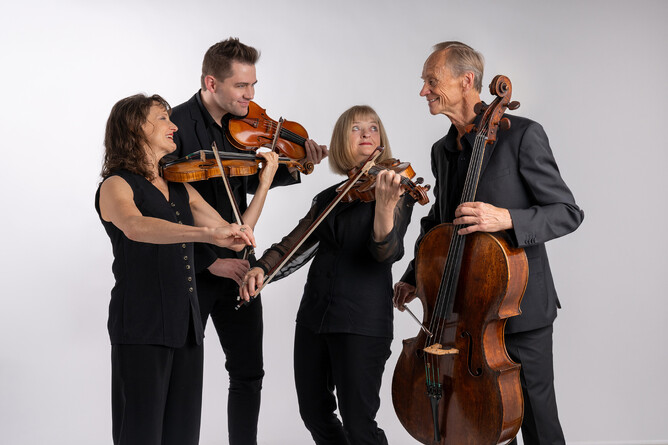Reviewed by Andrew Buchanan-Smart
Works by: Mascagni, Clare Cowan, Beethoven and Debussy
Helene Pohl and Peter Clark violin, Gillian Ansell viola and Rolf Gjelsten cello
The concert began with a special performance of Mascagani’s Intermezzo from Cavalleria Rusticana performed by the musicians from Youth Orchestra Waikato and the New Zealand String Quartet (NZSQ). It was lovely to see and hear the next generation of talented musicians perform with New Zealand’s premiere string quartet. The performance of this wonderfully romantic work was simply sumptuous.
Clare Cowan’s Celestia><Terralia used minimalist musical techniques to great effect, allowing the music material to develop gradually. This organic process reflected the parallels between the celestial space and earth. The energy within the work seems to derive from the natural cosmic forces that surround us. The juxtaposition of both micro and macro fragments mirroring themselves were cleverly portrayed by the NZSQ, capturing the essence of this work both physically and metaphorically.
Beethoven’s String Quartet No.16 Op.135 in F major, composed in 1826, the year before he died, for me represents a profound understanding of his condition, meaning the work has the ability of Janus: to look both backwards and forwards at the same time. He presents an echo and distillation of his life as a composer, capturing the deep introspections from the past and manages to achieve a forward vision with clarity and transparency. As an epilogue he captured the spirit of the time. The challenge for the performers is not only to capture the vast range of techniques required, but to musically portray them in such a way as to reflect the enormous contrasts within the piece, capturing all the subtleties and musical nuances and extravagancies throughout. The NZSQ achieved this feat superbly, nowhere more so than in the third movement capturing a profound sense of peace in a performance to remember.
The sensuality and impressionistic tonal shifts of Debussy’s String Quartet Op.10 in G major are emblematic of its time and place, and its cyclic structure constitutes a divorce from the rules of classical harmony into a new style. Debussy wrote that "Any sounds in any combination and in any succession are henceforth free to be used in a musical continuity." Debussy was strongly influenced by the Impressionistic painters of his day.
Debussy’s use of texture and sonority has often been compared with the Impressionistic painter’s fascination with light. In this way, this quartet can be seen almost as a musical painting, reminding me of Monet’s Garden at Giverny, with this being a musical expression of light. Harmonic colours and melodic links throughout reflecting tonal hues, homogeneous sound and vibrant textures, all wonderfully performed by the NZSQ as they captured the musical essence from dawn to dusk at Giverny.
This superb venue with its natural acoustic greatly added to the enjoyment of this very fine performance.


